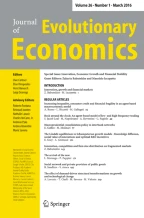Abstract.
In this paper, we aim to discuss whether Schumpeterian models of endogenous growth can accommodate Schumpeter’s vision of development through creative destruction. Taking a methodological approach, our focus is on individual decision-making, technology, general equilibrium and welfare, and steady state dynamics as the fundamental principles underlying endogenous growth theory. In particular, the Aghion-Howitt model of Schumpeterian growth in various extended versions is analyzed in the light of Schumpeter’s work. Therefore, we also try to root Schumpeter’s work in historical context. We find endogenous growth theory far from carrying Schumpeter’s idea of an evolutionary approach to change and development. Rather the emergence of numerous models of an evolutionary type can be observed to provide for the formal structure appropriate to keeping Schumpeter’s legacy alive.
Similar content being viewed by others
Author information
Authors and Affiliations
Corresponding author
Additional information
JEL Classification:
B1, B2, B4, O3, O4
Corespondence to: Thomas Kuhn
Rights and permissions
About this article
Cite this article
Alcouffe, A., Kuhn, T. Schumpeterian endogenous growth theory and evolutionary economics. J. Evol. Econ. 14, 223–236 (2004). https://doi.org/10.1007/s00191-004-0205-0
Issue Date:
DOI: https://doi.org/10.1007/s00191-004-0205-0
